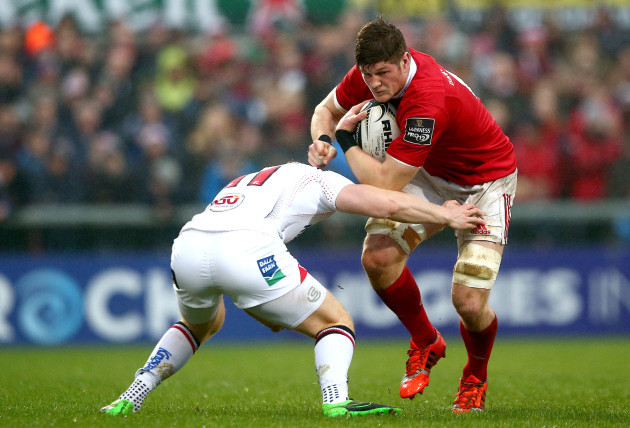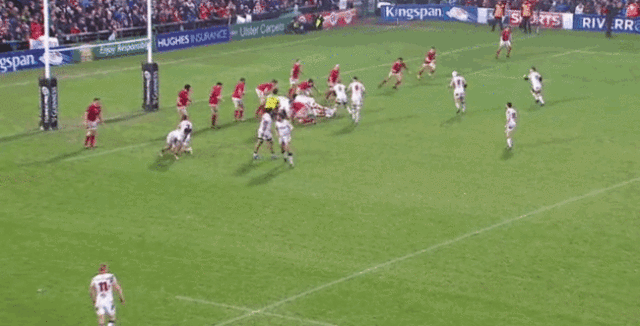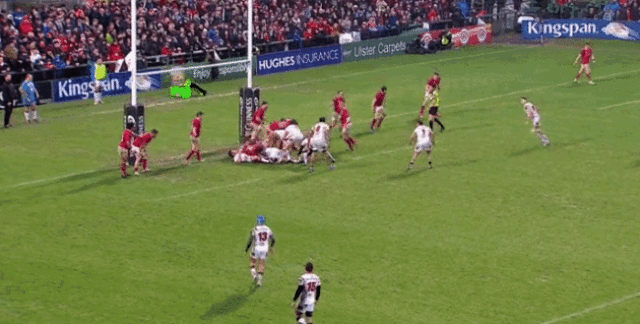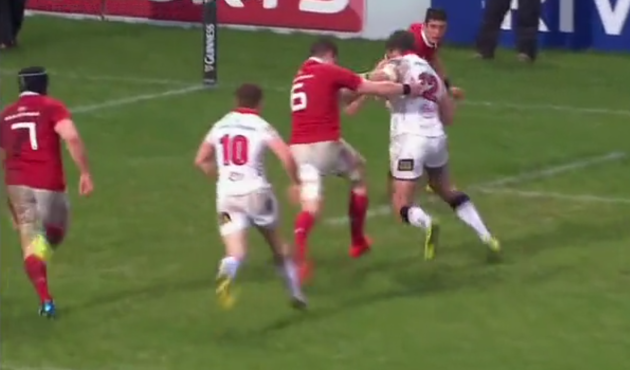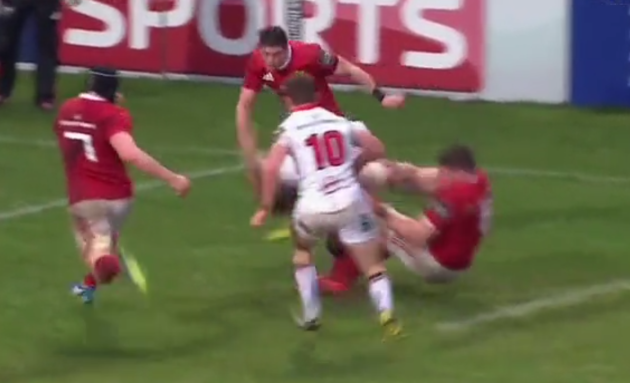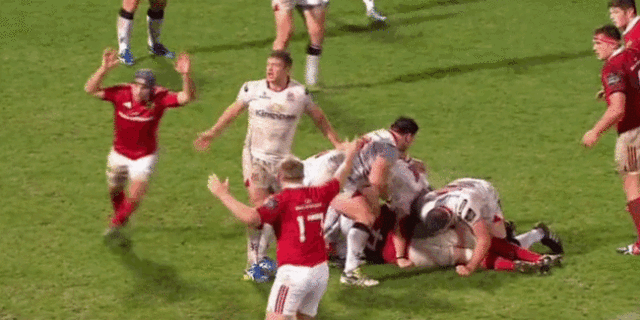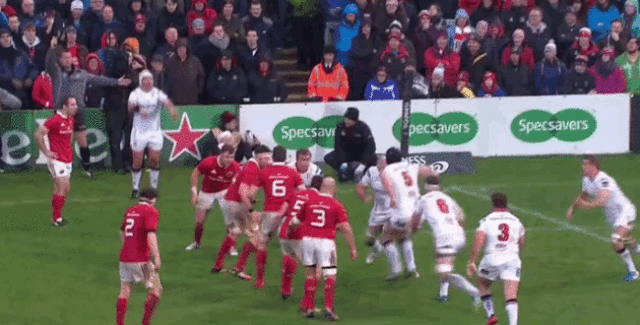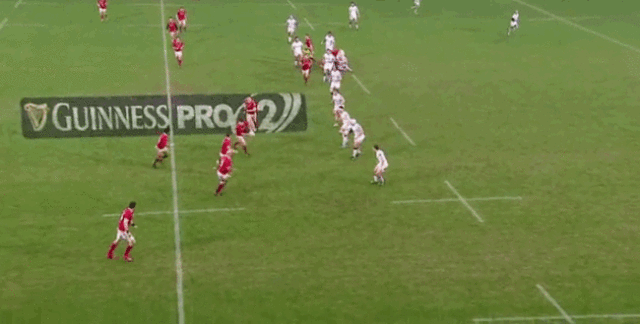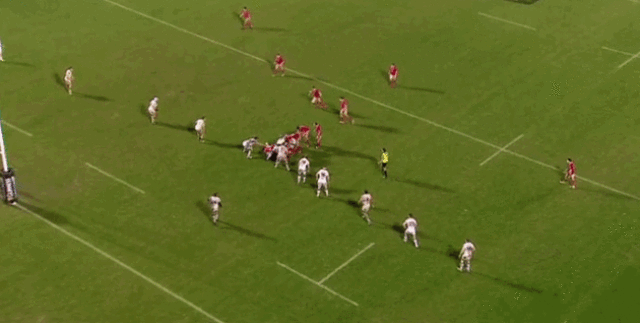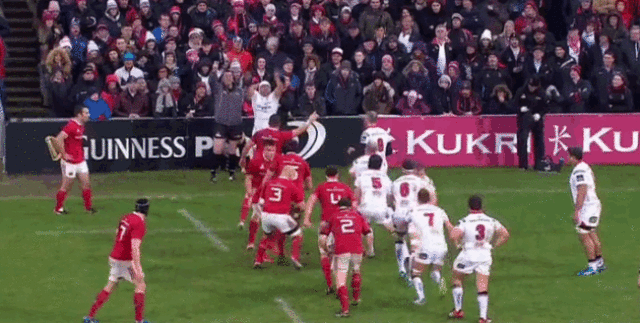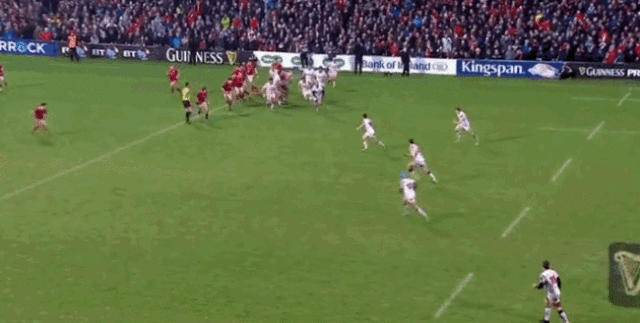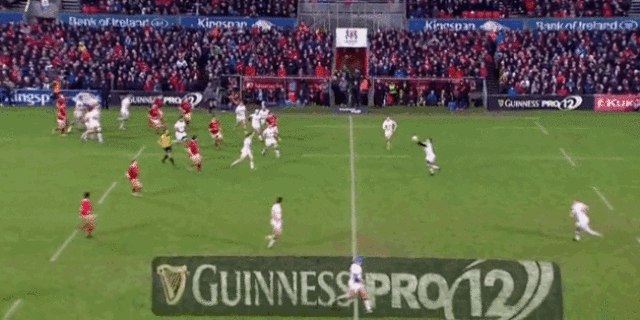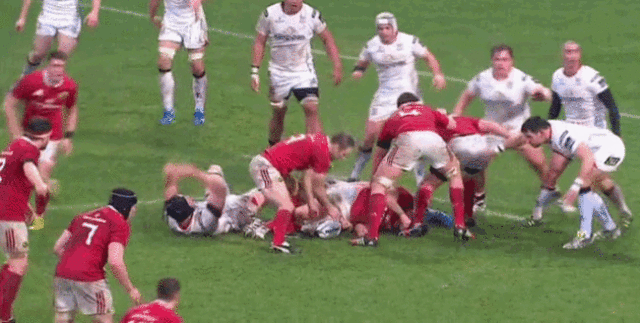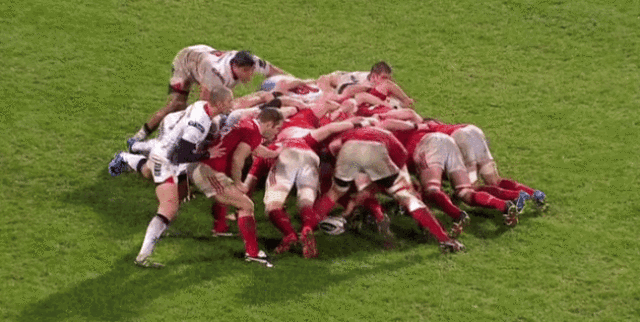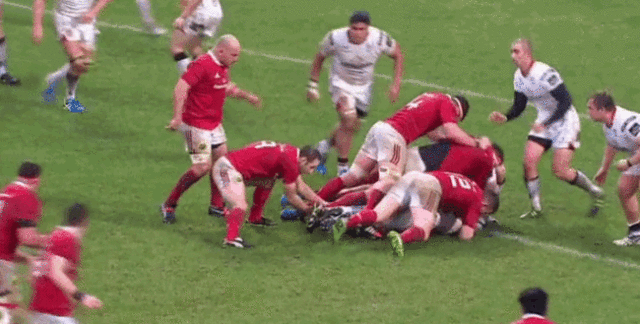MUNSTER STILL HAVE major improvements to make as they look to turn their season around, but a 9-7 win against Ulster in Belfast last weekend was heartening for the province.
Their attack urgently needs to find a clinical edge, but defensively there were notable strides of progress on Saturday as the individual errors and glaring missed tackles that had plagued them recently were largely eradicated.
One of the other reasons for the upturn in form from Anthony Foley’s side was the fact that they could field their preferred back row for the first time this season, the long-term absence of Peter O’Mahony taken into account.
Coming into the second half of the campaign, it’s likely that Foley would have seen Tommy O’Donnell, CJ Stander and Jack O’Donoghue as the most ideal trio at the back of the scrum, but O’Donnell’s hip dislocation while on Ireland duty in August greatly delayed any such plan.
The return of O’Donnell, Munster’s player of the year in 2013 and a nine-cap Ireland international, is vital for the province. The Tipperary man was impressive on his first start since recovering from his hip injury, allowing Munster a genuine balance in their back row.
The week before this Ulster win, Munster had fielded a back row of Stander, O’Donoghue and Robin Copeland in defeat to Leinster – three players who have largely made their names as number eights. With O’Donnell back, the blend is far more ideal.
O’Donnell’s absence had seen O’Donoghue tasked with filling in on the openside this season, the Waterford man making a total of nine starts in the seven shirt. O’Donoghue’s presence at seven underlines the faith Foley and his coaching staff have in him, while the experience will surely have accelerated his development towards being a complete back row player.
The 21-year-old is highly rated within the province and his performance at blindside flanker against Ulster was the latest illustration of why.
O’Donoghue’s stint on the openside saw him grow and grow in terms of being a breakdown threat, as he became more proficient in understanding when to attack the ball and when to stand off.
The jackaling effort above draws a penalty for Munster as Rory Best enters the contest from the side in an attempt to remove O’Donoghue before he can win a clean steal of possession.
The identification of a turnover opportunity by O’Donoghue is excellent, as he times his arrival perfectly to clamp down directly onto the ball.
O’Donoghue’s effect on the breakdown and ruck area was generally superb against Ulster as he had a total of 27 involvements. We’ll touch on his attacking rucking a little later, but defensively he made four contributions. As well as the turnover above, he managed to slow Ulster possession once and was also present (forcing Ulster to target him with their clearout) twice.
The UL Bohs man will only continue to improve as a breakdown threat as Foley pushes him to be more effective.
O’Donoghue completed a total of 11 tackles when Munster were forced to defend, with the example above perhaps the highlight.
As anyone who has been watching Ulster this season will know, taking Stuart McCloskey down is not a straightforward matter. Just six metres out from the tryline, the Bangor man would have backed himself to score here, but O’Donoghue does a wonderful job to prevent the try.
McCloskey receives the ball with enough space to use a trademark burst off his left foot, which leaves O’Donoghue forced to tackle with his arms rather than being able to chop in low on the big Ulster centre’s legs.
McCloskey shoots up his powerful left-handed fend, as we can see above, and it leaves O’Donoghue in a worrying position. Many a defender has lost out to McCloskey in exactly this type of situation before, going in high with their arms – all branches and no trunk.
O’Donoghue recognises that he’s in a relatively weak position and reacts intelligently, gripping onto McCloskey firmly with two hands and whipping his body around the Ulsterman to ensure that momentum brings McCloskey to ground in a wrestling-like manoeuvre.
A vitally important tackle in the first half as Ulster hammered at Munster’s tryline.
There was another small example of O’Donoghue’s defensive intelligence later in the game, as he avoided conceding a penalty in the instance below.
Paul Marshall quick-taps a penalty for Ulster and the obvious temptation for O’Donoghue is to dive into a tackle from an offside position, therefore immediately compounding Duncan Williams’ penalty error with another one.
Instead, O’Donoghue backs away until he’s 10 metres from the initial penalty spot and then completes his tackle. It’s a seemingly insignificant thing to highlight maybe, but it indicates a player with strong discipline, such a vital attribute for any back row.
O’Donoghue’s dynamic physical make-up allows him to be an excellent lineout player, and again that’s an attractive feature for any coach when selecting back rows.
Above, we see O’Donoghue stealing possession for Munster at the lineout with an excellent leap, one aided by the lifting of Mark Chisholm and Billy Holland. There were also a pair of lineout breakdowns for Munster on their own throw with O’Donoghue as the target, but both appeared to be collective issues rather than on his shoulders.
O’Donoghue built much of his reputation in underage rugby on his exceptional ball carrying and a startling burst of pace, something that has transferred well into the senior game.
Some of his carrying this season has been exceptional – as against Leinster late last month – although he was provided with only three opportunities to carry in the Ulster clash.
Munster’s current game plan involves lots of wide patterns, and oftentimes O’Donoghue is the man waiting for the ball to arrive on the edges. It can be a thankless task, particularly for a back row who prides himself on making yards with the ball.
In the example above, the ball does arrive to O’Donoghue and he carries well, but other times this season he has been starved of attacking chances. Actually maintaining the discipline to hang out wide – as the tactics dictate – requires a degree of selflessness.
Other back row forwards might wander infield in search of a chance to carry hard and further their own cause. O’Donoghue understands what is required of him and holds his width.
With fewer carrying opportunities, the former Waterpark man did have to hit a relatively high number of rucks as Munster attacked.
O’Donoghue arrived first to nine of his side’s rucks, making seven effective contributions and acting as guard twice. He was second man in seven times, including four effective markings, and was involved in a further seven rucks as third or fourth arriving player.
Above, we see one of O’Donoghue’s most important rucking actions, as he clears well beyond the ball to lengthen the ruck and provide Ian Keatley with that extra split second to fire over his drop goal.
The depth of O’Donoghue’s clearout means Chris Henry is forced to take an additional four or five steps back towards Ulster’s posts in order to avoid getting caught up in the ruck. As a direct result, his attempt to charge down Keatley’s kick comes up short.
While O’Donoghue completed the full 80 minutes for Munster, moving over to the openside for the closing 24 of those, O’Donnell was replaced after 56 minutes of the game.
To get through that amount of game time on his first start since 8 August speaks volumes of the effort O’Donnell has made in training during his recovery from his hip dislocation. While it might not have been a headline-maker, this performance from O’Donnell was high quality.
Despite coming off with 24 minutes left, O’Donnell was joint leader of the tackle charts for Munster with 11. That number doesn’t really tell us anything in truth, but a closer look at the UL Bohs flanker’s tackling highlights the qualitative value of his defence.
Above, we see O’Donnell chopping McCloskey down before he can bust the gainline, again something the Ulster midfielder has done with eye-opening frequency this season.
O’Donnell is the tailgunner at the rear of Munster’s lineout, and he carries out his job to perfection here as he bursts away from the 15-metre line and brings McCloskey to ground instantaneously.
The openside is also serving to protect his out-half here. Keatley is involved in the tackle, but McCloskey isn’t running directly at him one-on-one. Other sides have targeted the Munster playmaker in this manner regularly this season, but O’Donnell is on scene to cut McCloskey down on this occasion.
Ulster reacted by getting far flatter with a later carry from lineout possession, as we see below, meaning O’Donnell can’t get into place to be involved in the first contact on McCloskey.
McCloskey actually manages to power through Keatley’s low tackle this time, but assist tackler Rory Scannell does a fine job of holding him up before O’Donnell arrives in to drive into McCloskey and send him to deck.
Not content with involvement in the tackle, O’Donnell works back to a standing position, pulls Henry through over the ball, and then reaches a disruptive right boot out at the ball.
There’s no turnover, but O’Donnell has crucially managed to slow the Ulster possession and allow his own team time to set their defensive line.
The 28-year-old generally hit hard in this fixture, as in the case below. Another feature of O’Donnell’s defensive effort was his willingness to chase hard when Munster kicked the ball.
Those two factors are combined in the above example, as O’Donnell forces a turnover with a firm hit on Louis Ludik when the Ulster fullback looks to counter-attack.
O’Donnell’s thirst to be on-scene first is always important for Munster, and it was highly evident against Ulster. He chased hard to shut down counter attacks and recovered the ball four times after Ulster had spilled.
Opensides so often find themselves in the right place at the right time, but hard work and intuitive reading of the game mean it’s no accident.
As with O’Donoghue, O’Donnell’s opportunities to carry weren’t as plentiful as he might have wished, but he was solid when called upon in congested areas.
As his fitness grows and games allow it to, O’Donnell’s carrying will return to its previously excellent standard, although the clip above demonstrates some of the sharp footwork the openside possesses.
O’Donnell had a total of 20 ruck and breakdown involvements for Munster last weekend, with five of those coming on defence. While he never managed to win the breakdown turnover he hungered for, there was one instance of slowing Ulster possession and another four present markings.
Munster have dipped somewhat in their collective breakdown efforts defensively this season with Paul O’Connell and Peter O’Mahony missing, but O’Donnell’s return will add to their competitiveness in this area.
O’Donnell had nearly as many passes in this game as he did carries, and that once again points to his all-round ability as a Test match player. He is comfortable in moving the ball through the hands when required and it’s another factor that will help Munster improve.
Above, we see him throw an accurate screen pass off his left hand to give Keatley more time to manufacture a superb clearing kick.
Oddly enough, given his endless bevy of man-of-the-match awards, number eight Stander was somewhat outshone by the other duo in Munster’s back row.
That said, the now Irish-qualified 25-year-old once again racked up a huge number of carries, making 33 metres in total from 17 carries.
There were some powerful runs from Stander when he managed to get any sort of one-on-one situations, as above, but Ulster did an excellent job on him much of the time.
Oftentimes, Stander found himself faced with two or three tacklers at a time, meaning his dent on the gainline was not as telling as it usually is. Ulster’s double-teaming tactics meant they could also target any high carries from Stander, as below.
McCloskey and Best combine here to get the initial choke in on Stander, while the impressive Kyle McCall piles in to help finish the turnover.
Munster’s number eight will likely look back at this as an instance where he went into contact too high. While he is more then capable of running right over the top of individual defenders, there is always the need to protect the ball in less advantageous positions.
Stander completed eight tackles and had a total of 14 ruck involvements for Munster. Tellingly, three of his four defensive actions in that area saw him slowing down Ulster’s possession. With O’Mahony and O’Connell out of the picture, Stander has taken on much responsibility in this department.
While Ulster managed better than most to keep Stander quiet, his work rate and willingness to repeatedly carry was a continuation of what we’ve seen all season.
As Munster look to keep their Champions Cup campaign alive against Stade Français at Stade Jean-Bouin in Paris on Saturday, their balanced back row will give them real belief.
- This article was updated at 17.18 to ensure the third and fourth paragraphs more accurately reflected the intended meaning. “the long-term absence of Peter O’Mahony taken into account” was added to the third paragraph and “the second half of ” was added to the fourth paragraph.
